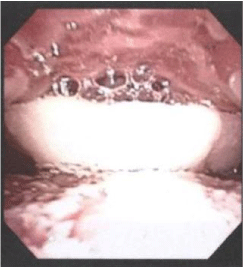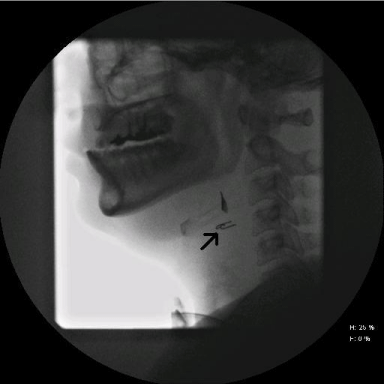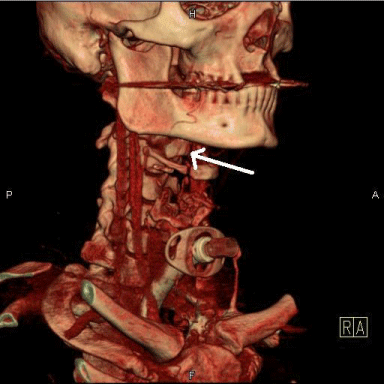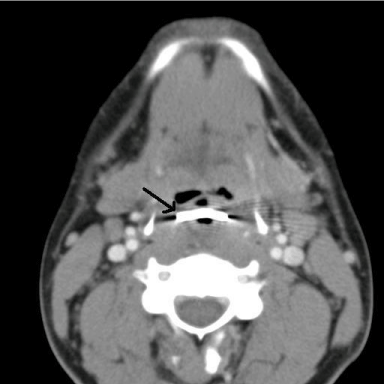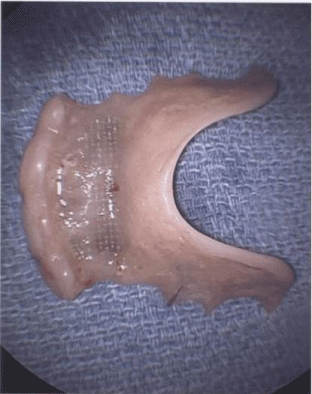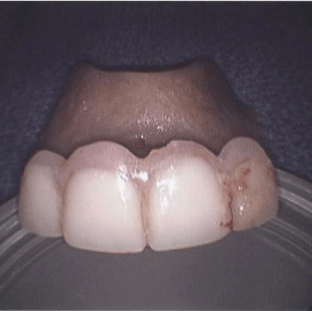Retained Denture in Oropharynx
Received: 24-Oct-2012 / Accepted Date: 26-Nov-2012 / Published Date: 30-Nov-2012 DOI: 10.4172/2161-119X.1000121
Abstract
Purpose: To describe an unusual case of a denture retained in the oropharynx for one year and highlight current management of airway foreign bodies.
Study design: A case report and brief review of the literature.
Results: A 27 year old man sustained a gunshot wound to the neck and underwent exploratory surgery and
tracheotomy at an outside hospital. Nine months after this injury, he presented to our clinic with dysphagia, aphonia, and tracheotomy dependence. Normal anatomic landmarks were not visible by indirect laryngoscopy and imaging suggested a possible plate-like prosthesis in the oropharynx. Diagnostic direct laryngoscopy revealed a foreign body firmly lodged in the base of tongue and vallecula. Removal of the foreign body revealed a partial denture. Postoperatively, the patient reported that he could not locate the denture after his injury and had obtained a new prosthetic. The missing partial denture was lodged in his oropharynx for one year.
Conclusions: While aspiration or dislodgement of dental appliances is common, this is an interesting case of a young man with a retained denture in his oropharynx for 12 months. During this time, the patient tolerated a near regular diet although swallowing was uncomfortable. Suspicion of a denture foreign body was low in this instance owing to the fact that the patient was young at presentation and did not endorse or disclose the loss of a dental appliance at the time of initial injury.
Introduction
Dislodgement and subsequent ingestion or aspiration of dental appliances is not uncommon. Usually, patients are able to provide a history of odontogenic foreign body aspiration that leads to timely retrieval. We report an unusual case of a patient with an undiagnosed oropharyngeal odontogenic foreign body retained for 12 months.
Case Report
A 27-year-old man presented with complaints of mild dysphagia and aphonia after sustaining a gunshot wound to the neck 9 months prior. The patient suffered reported injuries to his upper aero digestive tract and was tracheotomy dependent. The patient endorsed difficulty breathing and voicing around his tracheotomy. He was able to tolerate a regular diet but noted trouble with large pieces of solid food. On examination, the patient was unable to voice or breathe with occlusion of his tracheotomy tube. Flexible laryngoscopy showed pooling of secretions in the vallecula with abnormal white material in oropharynx (Figure 1). Identification of this white material was difficult secondary to secretions. After his initial evaluation, imaging studies were obtained to further investigate his abnormal anatomy. A modified barium swallow was performed which revealed pooling of boluses within the oropharynx and presumed surgical clips (Figure 2). There was no evidence of aspiration. A CT scan showed the traumatic deformities of the laryngeal cartilages. A plate-like prosthesis was noted in the region of the epiglottis (Figure 3). Twelve months after his injury, the patient underwent microdirect laryngoscopy under general anesthesia. Examination with a Holinger laryngoscope revealed a foreign body in the vallecula. Using rigid Hopkins rod telescopes, the object was identified as a partial denture. The patient’s oropharynx was exposed using a McIvor retractor and the denture was removed using forceps (Figures 4 and 5). Postoperatively, the patient disclosed that he had a partial denture that he presumed was lost. In follow-up, the patient noted immediate improvement in his swallowing.
Discussion
The overall incidence of odontogenic foreign bodies has been quoted at 0.4 to 0.7% [1]. Although aspiration of odontogenic foreign bodies is not uncommon, usually patients recognize the event leading to prompt removal. In patients with altered mental status due to neurologic conditions or trauma, foreign bodies are sometimes undiagnosed.This case highlights an unusual situation in which a partial denture was retained in the oropharynx for 12 months. In a review of ingested dental prostheses, the hypopharynx was the site of retention in only 3 of 21 cases [2]. In this case, several circumstances led to the unrecognized foreign body. The patient was not aware that he had swallowed his partial denture. Presumably, the denture was dislodged during this trauma. The patient underwent a series of surgical interventions at the outside hospital but these operative reports were unavailable. There was speculation that the foreign body identified on imaging represented a reconstructive plate. Sometimes diagnosis can be difficult as the material used to make dentures, polymethylmethacrylate, is radiolucent [3]. This particular denture had wire clasps which made it visible on imaging. However, the actual teeth were not identifiable. Interestingly, the patient had very mild subjective dysphagia and his main concerns were his tracheotomy dependence and aphonia. Even with the large foreign body lodged in his oropharynx, he tolerated a regular diet well. Delayed diagnosis of odontogenic foreign bodies can lead to significant morbidity including airway edema or obstruction and upper aero digestive tract perforation [3]. While previous reports of prolonged impaction of dental prosthetics exist [4], the duration in our case is unusual. In previously reported cases of younger patients, the patient makes providers aware of the issue [5]. In our case, the patient did not disclose the presence of a dental appliance. This highlights the importance even in younger patients of asking about missing dental prostheses during the evaluation of patient with dysphagia and possible foreign body. Additionally, thorough evaluation should be performed in patients who acutely present following a traumatic event with missing dentition. This is especially important in patients with altered mental status who cannot provide a reliable history. In such cases, endoscopy or imaging studies may be prudent. Our patient required additional endoscopic surgeries to address his laryngeal stenosis and at last follow-up was tolerating trach plugging 24 hours per day, had a serviceable plica ventricularis voice, and decannulation in the near future was planned.
References
- Rana I, Syed MI, Adams C, Clark LJ (2009) Hypopharyngeal foreign body masquerading as malignancy. Br Dent J207: 361-362.
- Abdullah BJ, Teong LK, Mahadevan J, Jalaludin A (1998) Dental prosthesis ingested and impacted in the esophagus and orolaryngopharynx. J Otolaryngol 27: 190-194.
- Haidary A, Leider JS, Silbergleit R (2007) Unsuspected swallowing of a partial denture. AJNR Am J Neuroradiol28: 1734-1735.
- Rathore PK, Raj A, Sayal A, Meher R, Gupta B, et al. (2009) Prolonged foreign body impaction in the oesophagus. Singapore Med J 50: e53-54.
- Lau G, Kulkarni V, Roberts GK, Brock-Utne J (2009) "Where are my teeth?" A case of unnoticed ingestion of a dislodged fixed partial denture. Anesth Analg 109: 836-838.
Citation: Huoh KC, Yung KC (2012) Retained Denture in Oropharynx. Otolaryngology 2:121. DOI: 10.4172/2161-119X.1000121
Copyright: © 2012 Huoh KC, et al. This is an open-access article distributed under the terms of the Creative Commons Attribution License, which permits unrestricted use, distribution, and reproduction in any medium, provided the original author and source are credited.
Select your language of interest to view the total content in your interested language
Share This Article
Recommended Journals
Open Access Journals
Article Tools
Article Usage
- Total views: 16229
- [From(publication date): 12-2012 - Dec 20, 2025]
- Breakdown by view type
- HTML page views: 11249
- PDF downloads: 4980

